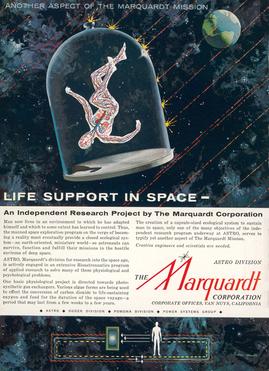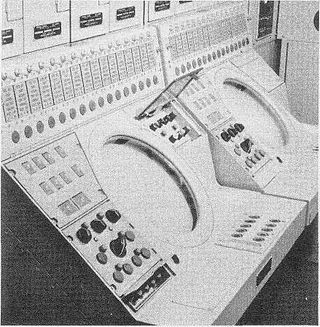Related Research Articles

The Hughes Aircraft Company was a major American aerospace and defense contractor founded on February 14, 1934 by Howard Hughes in Glendale, California, as a division of Hughes Tool Company. The company was known for producing, among other products, the Hughes H-4 Hercules aircraft, the atmospheric entry probe carried by the Galileo spacecraft, and the AIM-4 Falcon guided missile.

Marquardt Corporation was an aeronautical engineering firm started in 1944 as ‘’’Marquardt Aircraft Company’’’ and initially dedicated almost entirely to the development of the ramjet engine. Marquardt designs were developed from the mid-1940s into the early 1960s, but as the ramjet disappeared from military usage, the company turned to other fields.

Rome Laboratory is the US "Air Force 'superlab' for command, control, and communications" research and development and is responsible for planning and executing the USAF science and technology program.
Ground-directed bombing (GDB) is a military tactic for airstrikes by ground-attack aircraft, strategic bombers, and other equipped air vehicles under command guidance from aviation ground support equipment and/or ground personnel. Often used in poor weather and at night, the tactic was superseded by an airborne computer predicting unguided bomb impact from data provided by precision avionics Equipment for radar GDB generally included a combination ground radar/computer/communication system and aircraft avionics for processing radioed commands.

The 1st Combat Evaluation Group was a Strategic Air Command (SAC) unit. It was formed on 1 August 1961 to merge the 3908th Strategic Standardization Group for SAC aircrew evaluation with the 1st Radar Bomb Scoring Group that had originated from the 263rd Army Air Force Base Unit which transferred from 15th AF to directly under Strategic Air Command c. 1946. The 1CEVG formed after SAC switched to low-level tactics to counter Soviet surface-to-air missiles and SAC had "developed a Radar Bomb Scoring field kit for use in NIKE Systems" in early 1960 for scoring SAC training missions against US Hercules SAM sites. The 1CEVG headquarters included an Office of History and a "standardization and evaluation school" for command examiners.

Hughes Electronics Corporation was formed in 1985 when Hughes Aircraft was sold by the Howard Hughes Medical Institute to General Motors for $5.2 billion. The surviving parts of Hughes Electronics are today known as The DirecTV Group.

The Reeves AN/MSQ-77 Bomb Directing Central, Radar was a USAF automatic tracking radar/computer system for command guidance of military aircraft during Vietnam War bomb runs at nighttime and during bad weather. Developed from the Reeves AN/MSQ-35, the AN/MSQ-77 reversed the process of Radar Bomb Scoring by continually estimating the bomb impact point before bomb release with a vacuum tube ballistic computer. Unlike "Course Directing Centrals" which guided aircraft to a predetermined release point, the AN/MSQ-77 algorithm continuously predicted bomb impact points during the radar track while the AN/MSQ-77's control commands adjusted the aircraft course. A close air support regulation prohibited AN/MSQ-77 Combat Skyspot bombing within 1,000 yd (910 m) of friendly forces unless authorized by a Forward Air Controller, and "on several occasions" strikes were as close as 273 yd (250 m).

The Raytheon AN/MSQ-18 Battalion Missile Operations System was a Project Nike command, control, and coordination system for "each associated missile battery" to control a Nike missile as directed from a Raytheon AN/MSQ-28 at the Army Air Defense Command Post. Raytheon Company constructed the AN/MSQ-18 as 2 separate subsystems:
Radar Bomb Scoring is a combat aviation ground support operation used to evaluate Cold War aircrews' effectiveness with simulated unguided bomb drops near radar stations of the United States Navy, the USAF Strategic Air Command, and Army Project Nike units. USAF RBS used various ground radar, computers, and other electronic equipment such as jammers to disrupt operations of the bomber's radar navigator, AAA/SAM simulators to require countermeasures from the bomber, and Radar Bomb Scoring Centrals for estimating accuracy of simulated bombings. Scores for accuracy and electronic warfare effectiveness were transmitted from radar sites such as those at Strategic Range Training Complexes.
The Reeves AN/MSQ-35 Bomb Scoring Central was a United States Air Force dual radar system with computerized plotting board for evaluating the accuracy of Strategic Air Command bomber crews by the 1st Combat Evaluation Group.

Lima Site 85 was a clandestine military installation in the Royal Kingdom of Laos guarded by the Hmong "Secret Army", the Central Intelligence Agency, and the United States Air Force used for Vietnam War covert operations against communist targets in ostensibly neutral Laos under attack by the Vietnam People's Army. Initially created for a CIA command post to support a local stronghold, the site was expanded with a 1966 TACAN area excavated on the mountaintop where a 1967 command guidance radar was added for Commando Club bombing of northern areas of North Vietnam. The site ended operations with the Battle of Lima Site 85 when most of the U.S. technicians on the mountaintop were killed, including CMSgt Richard Etchberger. For his heroism and sacrifice, Etchberger received the Air Force Cross posthumously. The operation remained classified, however, and the existence of the award was not publicly acknowledged until 1998. After the declassification of LS 85 and a reevaluation of his actions, Etchberger was awarded the Medal of Honor in 2010.
Combat Skyspot was the ground-directed bombing (GDB) operation of the Vietnam War by the United States Air Force using Bomb Directing Centrals and by the United States Marine Corps using Course Directing Centrals. Combat Skyspot's command guidance of B-52s and tactical fighters and bombers—"chiefly flown by F-100's"—at night and poor weather was used for aerial bombing of strategic, close air support, interdiction, and other targets. Using a combination radar/computer/communications system at operating location in Southeast Asia, a typical bombing mission had an air command post turn over control of the mission to the radar station, and the station provided bomb run corrections and designated when to release bombs.
The AN/MPQ-2 Close Cooperation Control Unit was a truck-mounted post-World War II automatic tracking radar/computer/communication system for aircraft command guidance, e.g., missile tracking, and for Radar Bomb Scoring. For ground directed bombing (GDB), an operator would manually plot a target on the "Blind Bombing Plotting Sheet", then use the manual "E6B computer and bombing tables" to plot the release point for striking the target, after which a radar operator used the MPQ to acquire a track of the bomber near an initial point during which allowed ground control of the bomb run to the release point.
The Western Electric M-33 Antiaircraft Fire Control System was an X-Band "Gunfire Control Radar", for aiming antiaircraft artillery by computer control. Developed for mobility via 3 trailers, the "M-33 system could compute, for the 90-mm. and 120-mm. guns, firing data for targets with speeds up to 1,000 mph", and for targets at 120,000 yards had similar gun laying accuracy as "SCR-584 type radars" at 70,000 yards. The system included a telescopic "target selector" on a tripod near the guns for additional measurement of aircraft "azimuth and elevation data [to] be transmitted to the computer and utilized as gun directing data."
The AN/TPQ-2 Close Air Support System was a post-World War II radar/computer/communications system for automatically tracking an aircraft and guiding it to a predetermined bomb release point. The system was the predecessor of the General Electric AN/MPQ-14 Course Directing Central deployed to the Korean War for ground-directed bombing.
Matador Automatic Radar Control (MARC) was a command guidance system for the Martin MGM-1 Matador ground launched cruise missile that used combination radar/computer/communication centrals for ground-directed bombing. As for the earlier ground central used with the X-10 aircraft,* MARC had an "Air Link" from the ground for control and an airborne AN/APW-11A radar transponder on the missile for ranging. A series of "MSQ sites". each with a mobile AN/MSQ-1A central in 3 vans had an automatic tracking radar to geolocate the Matador up to ~600 nmi. MARC provided command guidance during the "mid-course phase" after Matador/MARC contact was established following the missile launch off the Zero Length Launcher and until an MSQ transmitted the dive ("dump") command to start the flight path toward the target. Originating in the Caltech/Martin "ZEL Project" and developed as part of weapon system "Project MX 771" at the "Air Force Missile Test Center, Cocoa, Florida"; MARC had accuracy at "crossover into enemy territory" of ~500 ft (150 m) and—at an AN/MSQ-1A range of 165 nautical miles —a CEP of 2,700 ft (820 m).
The 3903rd Radar Bomb Scoring Group was a military evaluation unit under direct command of Strategic Air Command (SAC) headquarters for scoring simulated bomb runs using automatic tracking radar stations. Initially an Army Air Forces Base Unit (AAFBU) and then a squadron, the 3903rd RBS Group was personnel, assets, and detachments were redesignated the 1st Radar Bomb Scoring Group and then the 1CEVG Radar Bomb Scoring Division when the RBS Group merged with the 3908th Strategic Standardization Group in 1961, the year RBS Express trains began to be used for low-altitude Boeing B-52 Stratofortress operations..
The Reeves AN/TSQ-96 Bomb Directing Central was a Cold War automatic tracking radar/computer/communications system.
The Reeves AN/MSQ-1 Close Support Control Set produced by Reeves Instrument Corporation was a trailer-mounted combination radar/computer/communication developed under a Rome Air Development Center program office for Cold War command guidance of manned aircraft Developed for Korean War ground-directed bombing, one detachment of the 3903rd Radar Bomb Scoring Squadron bombed itself with an MSQ-1 because it mistakenly used procedures for the earlier SCR-584/OA-294 system The MSQ-1 was subsequently used for nuclear testing during Operation Teapot, and for aircraft tests such as for "MSQ-1 controlled pinpoint photography" in 1954.
References
- ↑ "US v. Morton Sobell" (PDF). Retrieved 12 November 2012.
Reeves is just six years old
- ↑ National Research Council (U.S.); Callie Hull (1946). Industrial Research Laboratories of the United States: Including Consulting Research Laboratories. National Research Council. p. 261. Retrieved 2015-01-02.
- 1 2 John Q. Smith; David A. Byrd, SSgt, USAF (June 1951). "Forty Years of Research and Development at Griffiss Air Force Base" (PDF). dtic.mil. Archived from the original on April 8, 2013. Retrieved 2015-01-02.
{{cite web}}: CS1 maint: multiple names: authors list (link) - 1 2 Dynamics Corporation of America v. United States, tbdU.S.tbd (October 15, 1971)("…the gain from this real estate sale should be attributed to Reeves Instrument Corporation, a wholly owned subsidiary of the plaintiff … Claude Neon, Inc. … Effective April 15, 1955, [Neon] merged into Dynamics Corporation… Effective January 20, 1956, Reeves-Ely Laboratories, Inc…also merged into Dynamics. Prior to the latter merger, Reeves-Ely had been a controlled subsidiary of Neon").